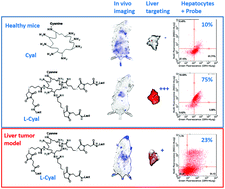Assessment of the targeting specificity of a fluorescent albumin conceived as a preclinical agent of the liver function†
Abstract
In the context of increasing liver diseases, no contrast agent is currently available in Europe and the United States to directly assess the liver function. Only neolactosylated human serum albumin is being clinically used in Asia. In order to perform preclinical studies in the context of liver diseases, we conceived a fluorescent lactosylated albumin for the quantification of liver functional cells (L-Cyal). Precise characterization was achieved in order to determine the amounts of lactose and Cyanine 5 (Cy5) coupled to the albumin. In addition, potential aggregation was characterized by asymmetrical flow field-flow fractionation hyphenated to multi-angle light scattering (AF4-MALS). The optimal functionalized albumin exhibited a mass greater than 87 kDa which corresponds to the addition of 34 lactose moieties per protein and 1–2 Cy5 labels. Also, no significant formation of aggregates could be identified due to the modification of the native albumin. In healthy mice, the accumulation of L-Cyal in the liver and its selectivity for hepatocyte cells were shown by optical imaging and flow cytometry. Administration of L-Cyal to mice bearing liver metastases showed a reduced signal in the liver related to a decrease in the number of hepatocytes. The L-Cyal bioimaging contrast agent could be particularly useful for assessing the state of liver related diseases.



 Please wait while we load your content...
Please wait while we load your content...